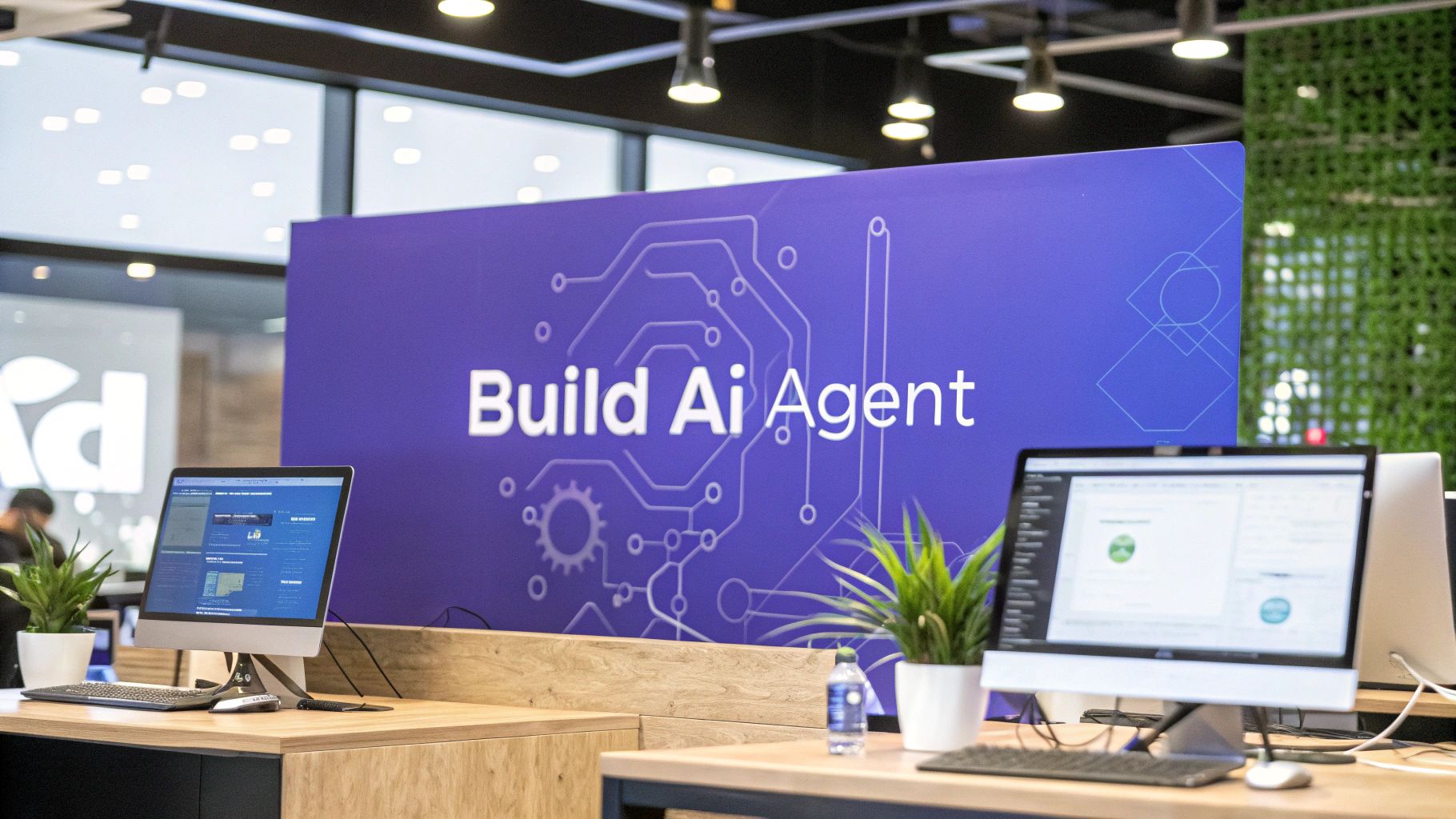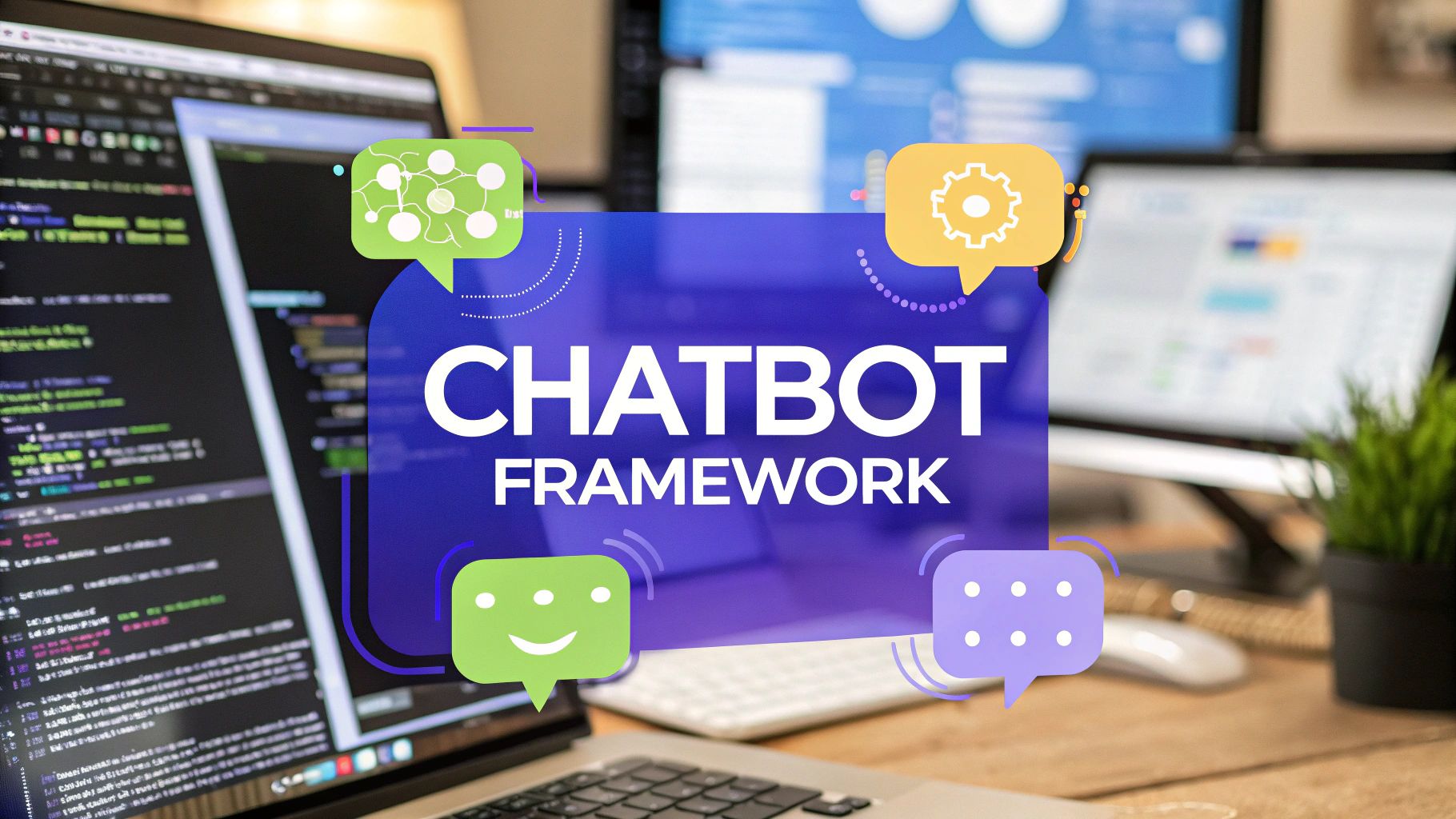Help Desk Software Comparison Made Simple
Struggling to choose the right platform? Our detailed help desk software comparison reviews top tools, features, and pricing to help you find the perfect fit.

Picking the right help desk software is a huge decision. Get it right, and you’ll see your team’s productivity soar and operations run smoothly. But get it wrong, and you’ll create frustrating bottlenecks for everyone involved. This guide will help you make a smart choice with a practical comparison of the top tools out there.
Why a Help Desk Software Comparison Is Critical

Many businesses still manage support with disorganized inboxes, slow response times and no clear view of team performance. Moving to a dedicated help desk platform stops those chaotic email threads and messy spreadsheets and creates a single source of truth for every customer conversation.
That shift impacts your bottom line. When your team works with the right tools, they can solve problems faster. Better support leads to higher customer retention and more repeat business.
The market for these tools is growing fast. Globally, help desk software is set to rise from $11.24 billion in 2024 to nearly $23.58 billion by 2035. That trend reflects the demand for automation and efficiency in customer support. Check out the full research on help desk software market trends to see how cloud solutions are taking over.
Key Evaluation Criteria
Before comparing features, pick a framework that focuses on the results you need rather than technical specs alone. Look at these core areas:
- Ticket Management: How does the software handle incoming requests? Smart ticket routing, status tracking and clear agent ownership are must-haves.
- Automation Capabilities: Can it take repetitive tasks off your team’s plate? Consider automated replies, ticket assignments or escalating urgent issues without manual work.
- Reporting and Analytics: Does it offer clear, in-depth insights? You need data on response times, resolution rates and customer satisfaction scores.
- Ease of Use: How quickly can your team start using it? A complex system slows you down before it speeds you up.
- Scalability: Will this tool grow with you? Think about future needs like adding agents or supporting new channels such as live chat or social media.
A good help desk software comparison focuses on the tool that solves your team’s specific problems and fits how you already work.
Defining Your Needs Before Comparing Tools
Before you jump into a dozen demos, take a step back to nail down what your team really needs. This avoids feature overload and endless sales calls that often lead to the wrong choice.
First, gather some basic numbers:
- Team Size: How many agents need access now? Include part-timers or anyone who jumps in to help.
- Ticket Volume: What’s your average tickets per day, and what do peak days look like? Choose a tool that handles chaos, not just calm.
- Communication Channels: List every channel customers use: email, chat, social media DMs, phone calls or SMS.
- Growth Plans: Where will your team be in the next 12 to 24 months? A tool that fits today might feel cramped in a year.
- Technical Resources: How comfortable is your team with new software? Do you have in-house IT support or does it need to be plug-and-play?
Assess Your Current Support Workflow
Map out how a ticket moves from start to finish, from the moment a customer sends an email to the final resolved click. Spot handoff points and bottlenecks where things get stuck.
You might find emailed requests waiting in a shared inbox for hours. That shows you need smart routing or automation to assign tickets instantly.
A recent study showed 82% of teams who mapped their workflows chose tools that cut resolution time by 25%.
Here’s a simple way to break it down:
- Identify every entry point for support requests (email, chat, form, etc.).
- Track how long a ticket sits at each stage. Log it for a week in a simple spreadsheet.
- Spot repetitive tasks done over and over. These are your prime candidates for automation.
- Note recurring mistakes or miscommunication points. Where do issues pop up most often?
Create a Personalized Checklist
Use your workflow insights to build a checklist of must-haves. This will keep you focused on features you’ll actually use.
Think about integrations and self-service. Do you need your help desk to connect with your CRM? Should customers be able to find answers on their own? Check out our guide on knowledge base management systems to see how a knowledge base can power self-service.
Your checklist might include:
- Seamless CRM integration for a full customer view
- Built-in reporting with customizable dashboards
- A clean, user-friendly self-service portal
- Automation rules for routing, escalating and follow-ups
- Multi-language support for global customers
Also define your Service Level Agreements (SLAs). What are your target response and resolution times? Your tool should make tracking and enforcing SLAs easy. Decide which metrics matter most—ticket trends, agent performance or both. Finally, consider if you need custom roles and permissions.
For example, a small marketing agency handling 200 tickets a day found itself drowning in manual work. Their checklist prioritized automation and a self-service portal. They ruled out any tool that didn’t integrate with their CRM and Slack. This focused approach kept them from overspending on a complex solution and wasting weeks on training.
Evaluate Vendor Support
The software itself is only half the equation. Vendor support can make or break your experience.
- Support Response Time: How quickly do they troubleshoot their own customers’ issues? Look for public SLAs or user reviews.
- Community Resources: Are there active forums or user groups? A strong community signals a healthy product.
- Update Frequency: Check release notes or a blog. Are new features and fixes rolling out regularly, or has development stalled?
Review the vendor’s uptime guarantees and support SLAs. That due diligence will save you headaches later.
A Head-to-Head Help Desk Software Comparison
A feature list shows what a tool can do, not how it feels in day-to-day use. This comparison dives into Chatiant, Zendesk, Freshdesk and Zoho Desk through four key lenses: ticket management, automation, reporting and multi-channel support. This will help you see past marketing claims and focus on what matters.
Ticket Management Capabilities
Great ticket management forms the foundation of any support team. It turns a flood of requests into an organized workflow, ensuring nothing gets missed and every customer gets a timely response.
Zendesk offers a powerful, flexible ticketing system with custom fields and forms. Enterprises can capture specific data like bug type, product version and operating system from the first message.
Freshdesk wraps a robust system in an intuitive interface. Its team inbox view lets multiple agents grab unassigned tickets from one dashboard. This is a win for smaller teams where agents juggle many roles.
Zoho Desk presents a context-aware view. Agents see a customer’s full history—past tickets, recent activity and more—without switching apps. This 360-degree perspective helps agents deliver more personal support.
Chatiant brings ticketing into collaboration hubs like Google Chat and Slack. Agents can convert conversations into formal tickets, assign them and track progress without leaving their chat app. It’s ideal for teams that live in these tools and need a lightweight solution.
Key takeaway: Pick a ticketing system that fits how your team works. A system that’s too complex will slow a small team, while a simple one may lack detail for an enterprise.
Automation and Workflow Rules
Automation separates a good help desk from a great one. It handles repetitive tasks so your team can focus on issues that matter.
Freshdesk and Zendesk both offer strong automation engines. You can set rules to route tickets based on keywords in the subject line. For example, any email with “refund” can go straight to billing and be tagged high priority.
Zoho Desk’s AI assistant Zia analyzes ticket sentiment, flags frustrated customers and suggests relevant knowledge base articles. This proactive approach resolves issues before they escalate.
Help desk adoption rose from 42% of support teams in 2020 to 53% in 2024. With 60% of customers expecting a response within an hour and 81% trying self-service first, tools must deliver speed and smart self-service.
Chatiant stands out with custom AI actions. You can build AI agents that not only answer questions but perform tasks—like looking up order details or booking meetings. This moves beyond ticket routing to true workflow automation.
If you need more detail, see how problem management vs. incident management affects automation choices for technical support teams.
Reporting and Analytics
You can’t improve what you don’t measure. Reporting and analytics reveal team performance, bottlenecks and opportunities to boost the customer experience.
Zendesk delivers in-depth analytics with customizable dashboards. Track metrics such as first-response time, resolution time and customer satisfaction scores, then filter by agent, team or channel.
Freshdesk offers visually appealing reports out of the box. Its dashboards provide a quick snapshot of support health without a data analyst. This suits managers who need to share updates with leadership.
Zoho Desk taps into Zoho Analytics, merging support data with CRM or other business apps. This unified view shows how support interactions affect customer lifetime value.
Chatiant focuses on real-time analytics for AI agents. See which questions come up most often, track chatbot resolution rates and find gaps in your knowledge base. This approach suits teams dedicated to optimizing self-service and automation.
Multi-Channel Support
Customers use email, live chat, social media or phone. A top help desk unifies all channels into one view for agents.
Zendesk and Freshdesk lead in omnichannel support. Agents can start on live chat, follow up by email and switch to phone, all under one ticket. This seamless flow stops customers from repeating themselves.
Zoho Desk covers email, phone, chat and social platforms like Twitter and Facebook. Its interface lets agents switch channels without losing context.
Chatiant integrates with modern messaging platforms. It lives inside Google Chat and Slack and can embed as a chatbot on your website. This meets customers and teams where they already work.
Help Desk Software Feature Comparison
Below is a side-by-side view of each platform across our key criteria. This table helps you spot the best fit fast.
In the end, your priorities decide the best choice. If you need endless customization, Zendesk is a powerhouse. For a system your team can master in a day, Freshdesk is a solid pick. For deep customer context, Zoho Desk delivers. And for building AI agents inside chat tools, Chatiant offers a modern approach.
Evaluating AI and Automation Capabilities
AI and automation have moved from trendy features to the engine that lets a small support team operate like a larger one. They handle repetitive tasks so agents can tackle the problems that need human insight.
When comparing help desk software, this makes a big difference. The right automation affects your team’s efficiency, response speed and ability to offer help after hours.
It starts with basics like smart ticket routing. Instead of a manager assigning each new ticket, the system handles it. You could create a rule to send any email containing “invoice” straight to billing. It saves time and gets the ticket to the right person on the first try.
AI-powered reply suggestions speed up responses for common questions. The AI scans a customer’s message and pulls relevant answers from your knowledge base. Agents can send it as-is or add a personal note, shaving minutes off response times.
How Different Platforms Approach AI
Every help desk handles AI and automation differently:
- Zendesk and Freshdesk excel at rule-based automation. Create complex workflows to escalate urgent tickets or send follow-up satisfaction surveys.
- Zoho Desk uses its AI assistant Zia for proactive insights. Zia spots unhappy customers through sentiment analysis and highlights trends like a spike in bug reports.
- Chatiant focuses on custom AI agents that can do tasks. You can build an AI assistant for Google Chat or your website that looks up order details or books a demo automatically.
The real power of help desk AI lies in taking action, completing tasks for the customer and freeing up human agents for problems that require their skills.
What This Looks Like in Practice
For example, an e-commerce store running a massive sale might see ticket volume triple. With basic software, your team would get overwhelmed. But with solid automation, the system can sort and route tickets right away. All “where is my order?” inquiries can get an automated reply with a tracking link, resolving a large portion of tickets without agent intervention.
Good automation lets your team handle big volume spikes without hiring extra staff. It also gives customers what they want: instant, 24/7 answers to simple questions. To learn more about how helpdesk artificial intelligence is changing support, check our guide.
When you evaluate platforms, look past shiny feature lists. Ask for a demo that fixes one of your team’s recurring issues. The right tool should feel like a new team member, not just another piece of software.
Analyzing the True Cost and ROI

It’s tempting to fixate on the monthly subscription fee, but that figure rarely tells the full story. A real help desk software comparison looks at total cost of ownership, including hidden expenses.
Most platforms charge per agent, per month. But you may also face one-time setup fees or extra costs for must-have integrations like your CRM. Tiered pricing can lock vital features in higher plans. Map your must-haves to each plan to avoid surprises later.
Calculating Your Return on Investment
Real value comes from what the software saves you. ROI links the price tag to tangible gains in efficiency and productivity.
Support ticket costs range from $2.93 to $49.69, with a global average of $15.56 per ticket. Automation drives that cost down. Businesses report that 22% of tickets now resolve with almost no human touch, thanks to AI and self-service. For more data, see these help desk software statistics.
Estimate how much time your team wastes on sorting tickets or sending follow-up emails. The right software automates these workflows, freeing agents for work that moves the needle.
Here’s a simple ROI frame: “If this software saves each agent one hour per day, what is that time worth?” The result usually exceeds the subscription cost.
Building the Business Case
To get approval for a new tool, build a data-driven case. Start by calculating current support costs. Tally hours spent on manual tasks and estimate losses from slow response times that cost customers.
Next, project savings. If you cut resolution time by 15%, how much labor cost drops? If a self-service portal deflects 20% of tickets, that’s a direct workload reduction.
By attaching real numbers, you shift the view from an expense to a strategic investment. Our guide on help desk automation offers more examples of measurable gains. This approach wins stakeholder buy-in and leads to confident decisions.
How to Make Your Final Decision
Let’s be honest, there’s no single “best” platform in any help desk software comparison. The right choice depends on your team’s goals, budget and working style.
A small business needing an affordable, easy system will likely appreciate Freshdesk or Zoho Desk. Their intuitive interfaces mean fast setup without a steep learning curve.
A large enterprise with multiple support tiers and a thirst for advanced analytics may find Zendesk a better fit. Its extensive reporting and integration library handle complexity at scale.
A Checklist for Demos and Trials
Put software to the test with free trials and demos. Use this list to guide you:
- Solve a Real Problem: Can you build a workflow to automate a manual task? If it’s hard to set up, that’s a red flag.
- Test the Integrations: Does the software connect smoothly with your CRM and other apps? A poor integration is worse than none.
- Evaluate Agent Experience: Is the interface clean and easy to navigate? A clumsy UI slows everyone down.
- Check Reporting Depth: Can you create a custom report for your key metric, like first-contact resolution? Avoid vanity numbers.
- Assess Self-Service: Is the knowledge base simple to set up and easy for customers to search?
Your goal during a trial is to confirm the software fixes your team’s pain points and fits into existing processes without friction.
A Few Common Questions
Here are answers to questions that often surface during a help desk software comparison.
What’s the Single Most Important Feature in a Help Desk Tool?
A rock-solid ticketing system is the foundation you can’t skip. It captures every customer conversation, tracks progress from open to resolved and ensures nothing slips through the cracks.
If your team spends too much time on repetitive tasks, automation capabilities will be lifesavers. If you juggle questions across email, chat and social media, multi-channel support becomes your top priority.
How Much Should I Budget for Help Desk Software?
Prices range from free plans for one-person teams to enterprise solutions costing hundreds per agent per month. For most growing teams, popular tools fall in the $15–$25 per agent, per month range.
Look beyond sticker prices. Include setup fees, charges for integrations and the cost jump to unlock a critical feature on a higher tier.
Can I Switch to a Different Help Desk Later On?
Technically yes, but it’s a major project. Migrating years of customer data, ticket histories and knowledge base articles is more than a headache—it can stall your support team.
Invest the time up front. Use free trials, attend demos with tough questions and pick a tool that scales with you. That effort will save you plenty of pain later.
Ready to build powerful AI assistants that integrate directly with your team’s workflow? See how Chatiant can automate your help desk and customer support tasks inside Google Chat or on your website. Learn more at https://www.chatiant.com.


